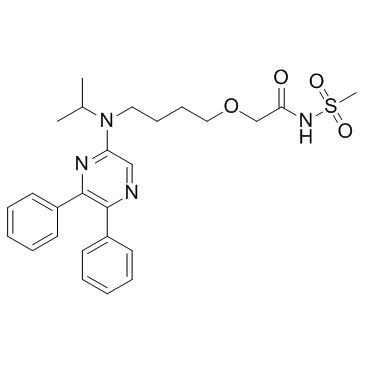475086-01-2
| Name | 2-[4-[(5,6-diphenylpyrazin-2-yl)-propan-2-ylamino]butoxy]-N-methylsulfonylacetamide |
|---|---|
| Synonyms |
2-{4-[(5,6-Diphenyl-2-pyrazinyl)(isopropyl)amino]butoxy}-N-(methylsulfonyl)acetamide
2-{4-[(5,6-diphenylpyrazin-2-yl)(propan-2-yl)amino]butoxy}-N-(methylsulfonyl)acetamide UNII-5EXC0E384L Selexipag Selexipag (JAN/USAN/INN) 2-{4-[N-(5,6-diphenylpyrazin-2-yl)-N-isopropylamino]butyloxy}-N-(methylsulfonyl)acetamide Selexipag [USAN:INN] Acetamide, 2-[4-[(5,6-diphenyl-2-pyrazinyl)(1-methylethyl)amino]butoxy]-N-(methylsulfonyl)- NS-304 |
| Description | Selexipag (NS-304) is an orally available and potent agonist for the Prostacyclin (PGI2) receptor (IP receptor). |
|---|---|
| Related Catalog | |
| Target |
IP Receptor |
| In Vitro | Selexipag (NS-304) is an orally available and long-acting IP receptor agonist prodrug, and its active form, MRE-269, is highly selective for the IP receptor. Selexipag (NS-304) inhibits the binding of [3H]Iloprost to the human and rat IP receptors in a concentration-dependent manner. The Ki is 260 nM for the human IP receptor and 2100 nM for the rat IP receptor. The intracellular cAMP levels in hIP-CHO cells are increased in a concentration-dependent manner by treatment with Selexipag (NS-304) with EC50 of 177nM. Selexipag (NS-304) also inhibits platelet aggregation in humans and monkeys with IC50 values of 5.5 and 3.4 μM, respectively, but it shows no inhibition in dogs (IC50 of >100 μM)[1]. |
| In Vivo | The Cmax of MRE-269 after oral administration of NS-304 is 1.1 μg/mL in rats and 9.0 μg/mL in dogs. Selexipag (NS-304) at 1 or 3 mg/kg increases FSBF in anesthetized rats for more than 4 h after intraduodenal administration in a dose-dependent manner. In particular, Selexipag (NS-304) at 3 mg/kg causes a sustained increase in FSBF and exhibits a maximal increase of 93% in FSBF 1 h after administration[1]. |
| Cell Assay | CHO cells expressing the human IP receptor (hIP-CHO cells) are seeded at 1×105 cells/well in a 24-well plate and cultured for 48 h. The cells are washed with Dulbecco's phosphate-buffered saline without divalent cations, preincubated in the medium for 1 h at 37°C, and then incubated for 15 min at 37°C with medium containing each drug in the presence of 500 μM 3-isobutyl-1-methylxanthine. The medium is removed, and perchloric acid solution is added to terminate the reaction. Intracellular cAMP levels are measured by enzymelinked immunosorbent assay[1]. |
| Animal Admin | Mice[1] Male Sprague-Dawley rats, cynomolgus monkeys, and male beagle dogs are used. Selexipag (NS-304) is orally administered to rats at 10 mg/kg and to dogs at 3 mg/kg, and blood samples are collected at various times and centrifuged to obtain plasma. The plasma concentrations of Selexipag (NS-304) and MRE-269 after oral administration of Selexipag (NS-304) to each animal are determined by high performance liquid chromatography coupled to mass spectrometry (LC/MS), and their pharmacokinetic parameters are calculated.Rats are orally administered Selexipag (NS-304) at 3 mg/kg twice daily for 1, 2, 3, or 4 weeks as a pretreatment. On the day after the final administration in the pretreatment, rats are anesthetized with urethane, and the FSBF is measured with a laser Doppler flowmeter after intraduodenal administration of Selexipag (NS-304) at 3 mg/kg[1]. |
| References |
| Density | 1.2±0.1 g/cm3 |
|---|---|
| Molecular Formula | C26H32N4O4S |
| Molecular Weight | 496.622 |
| Exact Mass | 496.214417 |
| PSA | 113.36000 |
| LogP | 4.56 |
| Index of Refraction | 1.579 |
